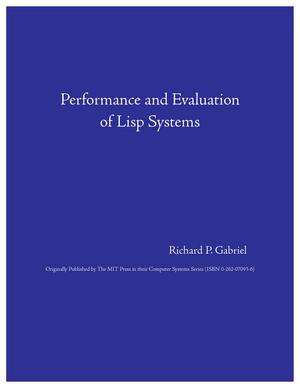
Performance and Evaluation of Lisp Systems
Provides detailed performance information using the tools of benchmarking to measure the various Lisp systems, and provides an understanding of the technical tradeoffs made during the implementation of a Lisp system.
Tag(s): Common Lisp
Publication date: 14 Aug 1985
ISBN-10: 0262070936
ISBN-13: 9780262571937
Paperback: 350 pages
Views: 15,104
Type: Book
Publisher: The MIT Press
License: Creative Commons Attribution-NonCommercial-ShareAlike 3.0 United States
Post time: 24 Apr 2008 12:11:07
Performance and Evaluation of Lisp Systems
 Provides detailed performance information using the tools of benchmarking to measure the various Lisp systems, and provides an understanding of the technical tradeoffs made during the implementation of a Lisp system.
Provides detailed performance information using the tools of benchmarking to measure the various Lisp systems, and provides an understanding of the technical tradeoffs made during the implementation of a Lisp system.
Publication date: 14 Aug 1985
ISBN-10: 0262070936
ISBN-13: 9780262571937
Paperback: 350 pages
Views: 15,104
Document Type: Book
Publisher: The MIT Press
License: Creative Commons Attribution-NonCommercial-ShareAlike 3.0 United States
Post time: 24 Apr 2008 12:11:07
Share — copy and redistribute the material in any medium or format
Adapt — remix, transform, and build upon the material
The licensor cannot revoke these freedoms as long as you follow the license terms.
Click here to read the full license.
This final report of the Stanford Lisp Performance Study, conducted over a three year period by the author, describes implementation techniques, performance tradeoffs, benchmarking techniques, and performance results for all of the major Lisp dialects in use today. A popular highlevel programming language used predominantly in artificial intelligence, Lisp was the first language to concentrate on working with symbols instead of numbers. Lisp was introduced by John McCarthy in the early 1960s (McCarthy's LISP 1.5 Programmer's Manual published in 1962 is available in paperback from The MIT Press) and its continuous development has enabled it to remain dominant in artificial intelligence.
Performance and Evaluation of Lisp Systems is the first book to present descriptions on the Lisp implementation techniques actually in use and can serve as a handbook to the implementation details of all of the various current Lisp expressions. It provides detailed performance information using the tools of benchmarking (the process of utilizing standardized computer programs to test the processing power of different computer systems) to measure the various Lisp systems, and provides an understanding of the technical tradeoffs made during the implementation of a Lisp system.
The study is divided into three major parts. The first provides the theoretical background, outlining the factors that go into evaluating the performance of a Lisp system. The second part presents the Lisp implementations: MacLisp, MIT CADR, LMI Lambda, S-I Lisp, Franz Lisp, MIL, Spice Lisp, Vax Common Lisp, Portable Standard Lisp, and Xerox D-Machine. A final part describes the benchmark suite that was used during the major portion of the study and the results themselves.
Tweet
About The Author(s)
Dr. Gabriel contributed to the development of Lisp and other infrastructure used by the artificial intelligence community. His contributions to the definition of the Common Lisp Object System set the stage for many object-oriented language features that were ahead of their time. He helped to develop Smalltalk and other infrastructure used by the object-oriented programming community, and has been influential in the ACM OOPSLA conferences, for which he created the Onward! Track to look for the next big advance in object technology.

Dr. Gabriel contributed to the development of Lisp and other infrastructure used by the artificial intelligence community. His contributions to the definition of the Common Lisp Object System set the stage for many object-oriented language features that were ahead of their time. He helped to develop Smalltalk and other infrastructure used by the object-oriented programming community, and has been influential in the ACM OOPSLA conferences, for which he created the Onward! Track to look for the next big advance in object technology.